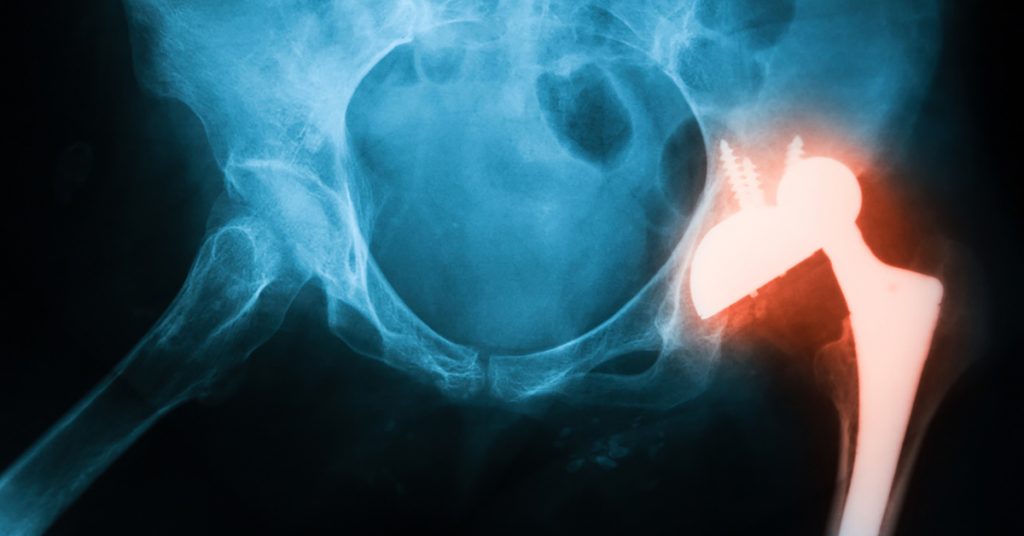A hip replacement is a major operation, so it’s important to do your research and make sure you’re fully informed before going ahead. This should include discussing all the pros and cons with your orthopaedic surgeon.
Before your surgery, Mr Nirav Shah will go through all the major complications associated with hip replacements. You’ll also receive detailed information in a follow-up letter to you and your GP.
Infection
If bacteria get into the soft tissues surrounding your hip during or after your operation it can cause an infection. Symptoms can include a high temperature; shaking and chills; inflammation and redness around your wound; and persistent pain even when you’re resting.
If you think that you may be suffering from an infection seek medical advice immediately and inform your surgeon.
Blood clots
For a few weeks following your surgery, you have an increased risk of developing a blood clot. This can occur in your leg (deep vein thrombosis) or lung (pulmonary embolism).
Deep vein thrombosis can cause pain, redness and swelling in your leg. If it’s not treated urgently it can result in pulmonary embolism, where the blood clot breaks off and blocks one of the blood vessels in the lungs.
A pulmonary embolism can be life-threatening. Call 999 or visit A&E if you’re struggling to breathe and/or your heart is beating very fast.
To reduce your risk of developing a blood clot, we’ll have you back on your feet on the day of your surgery and moving your ankles and toes while you’re resting. We also recommend compression socks to help increase blood flow.
Bleeding post-surgery
It’s normal to experience some bleeding from your incision after surgery. Sometimes this can be persistent, usually as a result of blood thinning medication.
In most cases this complication resolves itself within a few days. In the meantime, pressure can be applied to the wound and sometimes medication can be prescribed to help stop the bleeding.
Swelling
Some swelling is normal following any operation. However, in some cases it can persist for longer than expected. Approximately 6% of patients will suffer from long-term swelling, which can last for up to 18 months. Usually this is the result of poor circulation.
Swelling can also be a sign of deep vein thrombosis or an infection. It’s important to share your symptoms with your surgeon and seek immediate medical advice if you become concerned.
Neurovascular damage
Less than 1% of patients experience damage to their nerves and vessels during surgery. Damage to your sciatic nerve – a major nerve that runs down the back of the thigh – can cause ‘foot drop’, leaving you unable to lift the front part of your foot. General nerve damage can also occur, resulting in neurogenic pain, which can be permanent.
There are some important blood vessels surrounding your hip joint. If they’re damaged during surgery it can cause a lot of bleeding, which can result in significant post-operative swelling and potentially the need for a blood transfusion.
Leg length discrepancy
A small number of patients (approximately 2%) will experience a minor discrepancy between the length of their legs. A discrepancy of 3–6mm is considered normal and your body will be able to compensate. Around 25% of the general population are walking around with slightly different leg lengths.
Hip dislocation
Occasionally a new hip joint can dislocate and come out of its socket (see below X-ray). This affects approximately 2% of patients and it’s most likely to happen during your recovery while your hip is still healing. If you experience a dislocated hip, you’ll need another operation to correct it.
Joint stiffness
Another complication is stiffness of the joint. This happens when the soft tissues surrounding your hip replacement harden due to scarring, reducing the mobility of the joint. The likelihood of this complication occurring will be impacted by the severity of your arthritis and the complexity of your surgery.
Medication or radiation therapy can be used to help prevent stiffening of the joint if you are at risk.
Fractures
During your surgery there is a small risk of a fracture. The risk is slightly less if you are having a cemented hip replacement vs an uncemented hip replacement. The risk of a fracture can also be affected by the experience of your orthopaedic surgeon.
If a fracture does occur, it can usually be repaired during your operation. However, it may slow down your overall recovery.
Muscle damage
Damage to your muscles can happen during or after your joint replacement. Sometimes it’s caused by a pre-existing muscle weakness. Symptoms include pain, weakness and a limp. Other soft tissues, which include your ligaments and tendons, can also be damaged during surgery.
Wear and tear
Hip replacements can wear out and may need replacing – sometimes prematurely. Wear and tear will be affected by your level of activity and the bearing surface of your implant.
Hard-on-soft surfaces, for example ceramic-on-plastic and metal-on plastic implants create more friction and will wear out sooner than hard-on-hard bearing surfaces. Ceramic-on-ceramic hip replacements can last indefinitely providing they are placed in the optimum position.
Loosening of the joint
Loosening of your new hip joint can happen at any time, but it’s most likely to occur 10-15 years after your surgery. Due to thinning of the bone surrounding your prosthesis, your implant can become loose, causing pain and a feeling of instability.
Usually it’s possible to replace the loose hip replacement. However, not everyone is suitable for hip revision surgery.
Persistent pain
Long-lasting pain can be neurogenic, caused by nerve damage, or the result of a hip replacement that’s not in the optimal position. In rare cases, you can experience more pain after surgery than you were in before.
Minimising your risk
We work hard to reduce your risk of developing these complications. Mr Shah is a highly experienced surgeon and his complications rate is below the national average. He also has excellent support from his team, which helps to ensure you receive the best possible care and experience.






